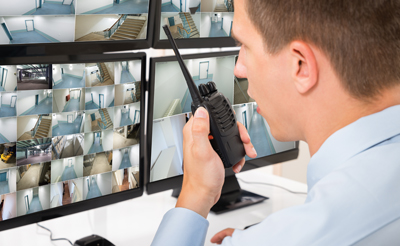
Robot or Real
What Is a Virtual Guard?
By Brie Shouppe / Published October 2019

You are probably starting to hear the word “virtual” more and more to describe various activities, many with little relation to one another. You can go virtual shopping without driving to a store, take a virtual tour of a school campus, or use virtual tracking to easily check on company inventory. The only commonality is that a person does not have to physically be in a specific place, making the action “virtual.” Just as we combine technology and software for everyday human behaviors and tasks, associations are utilizing these technological advancements to enhance their communities.
Virtual guarding can be used to secure many assets in a neighborhood, but who is behind the kiosk at a gated entrance? Whose voice is coming down from a camera? Who has the ability to view the footage being captured around an amenity? A very common misconception about virtual guarding is the idea that “virtual” means a computer or robot, in this instance. In actuality, it is a real person remotely monitoring that location.
A virtual guard is not just any person. In fact, virtual guards are (or should be) licensed security agents, often holding the same license as on-site, unarmed security guards. With this license, a guard has been trained on the principles of security, and many virtual guards undergo further training to learn the specific procedures and methods for responding from a remote station.
Depending on the provider, a remote monitoring center may include numerous virtual guards. With a pool of guards, an operating center has the ability to monitor many communities and their assets. The guards are able to share responsibilities and respond to multiple needs at the same time, even when those needs or incidents occur within a single community. Generally, a monitoring center also allows for the work of virtual guards to be under complete supervision, ensuring that they are carrying out their work in a timely, efficient, and professional manner.
A system with virtual guarding capabilities is frequently seen at gated community entrances. The kiosk that a visitor uses upon arriving at the community is connected to a remote guard or monitoring center of guards through an internet connection. When driving up to the community, a visitor may automatically trigger equipment that sends a signal to a virtual guard to prepare for response. A virtual guard is most likely able to see the driver and multiple other camera angles of the community entrance while speaking with the visitor. From there, the guard is able to verify whether or not the visitor is permitted to enter the community based on the methods used and orders in place from the association.
Virtual guards can often be heard at community amenities such as pools, sports courts, and clubhouses. The voice heard at any of these assets can easily be mistaken for a recording, but if a virtual guarding company is monitoring the area, then it is likely a real person with the ability to see, hear, and speak with anyone in that location. This type of system combines artificial intelligence to alert a remote guard when trespassers enter an area that is closed. Speakers incorporated into the system allow the guard to voice-down and inform trespassers that the area cannot be used at that time. While an initial “voice-down” may sound scripted and is thought to be a recording, technology today allows the remote guard to be very specific in identifying trespassers during additional voicings.
With the proper training, virtual guards are capable of more than verifying visitors and responding to incidents. They can help with the overall security of a community by also managing a resident database. This includes activating credentials for new community members and deactivating credentials for residents who move away or are not in good standing with the association. When an association does not keep an up-to-date database, the overall comm-unity security and the system investment are jeopardized.
If virtual guards are part of a larger operation center, it is possible that the health of the systems used are also being monitored. Since virtual guarding relies heavily on technology, it is necessary that the components are functioning properly to prevent disruptions in the virtual guard services. This can include connectivity to cameras and internet lines, power loss or system failures, battery status, and memory usage. This allows a central station to remotely diagnose many issues and address them prior to a system failing, when possible.
So, robot or real? Robotic is certainly not the right word or concept to describe something virtual. Instead, advanced technology has enhanced a real person’s ability to guard community assets without physically being at a site. As technology continues to evolve, we will see virtual services change and adapt to enhance capabilities, just as we have already seen many changes in the relatively short lifespan of systems that are “virtual.”
Brie Shouppe
Sr. Business Development Consultant, Envera Systems
Brie Shouppe is the Sr. Business Development Consultant for Envera Systems. She works closely with the sales and marketing departments to provide best-in-class service to the communities that Envera works with. Envera Systems is an all-inclusive security provider that focuses on the unique needs of communities through technology-based solutions. Using Virtual Guards located at Envera’s Central Station, Envera is able to provide Next Generation protection by verifying visitors, monitoring video, managing community databases, and more. Contact info: (855) 380-1274 or www.EnveraSystems.com.





